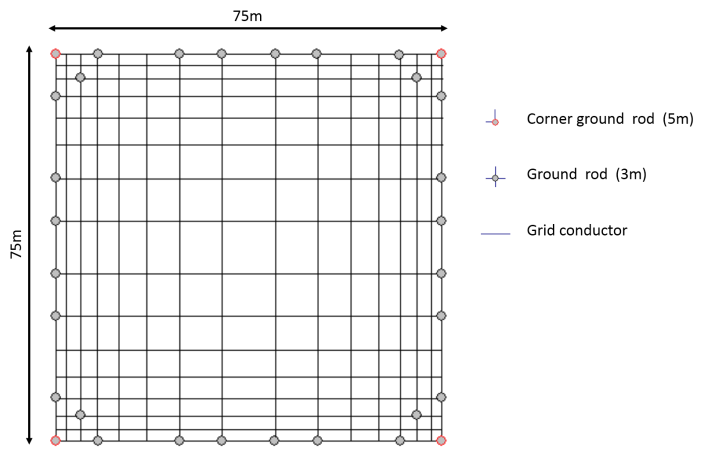compression
Grounding grid design of 132/11 kV transmission substation with vertical ground rods

This paper presents grounding grid design of 132/11 kV transmission substation with vertical ground rods. The soil resistivity is modeled as a uniform model. The preliminary design shows that the mesh voltage is exceeding the tolerable touch voltage. Therefore, a modification is necessary to improve the safety of the substation.
Design #2 is constructed by adding a crushed-rock protective surface layer and 60 ground rods with 3m long along the periphery. The result shows that the mesh and step voltage is lower than the tolerable values. The analytical calculation is then compared to computer simulation using ETAP Grounding Grid System. It shows a similarities between analytical calculation and computer simulation. However, because of the difference between mesh voltage and the tolerable touch voltage is very small, design #2 still needs to be improved.
The improvement design called design #3 is constructed using unequally spaced horizontal grid conductors with Optimum Compression Ratio (OCR) are analyzed analytically then the results are compared to ETAP simulation. Only 32 rods is used which consisted by 4 rods in the corner with 5m long and 28 rods along the periphery. The result shows significant improvement in mesh voltage and step voltage. Hence, design #3 is a safe and effective solution. It also have been estimated that the total cost material required for design #3 is USD 42,100.
Simplified probability risk assessment is calculated to support the design. Individual risk calculation implies that design #3 is safe because it has no risk of ventricular fibrillation in the vicinity of the substation.
The safety of people in and around high voltage substations is of primary concern when evaluating the performance of a substation grounding grid system. The risk arises as a result of rise of earth potential during power system earth fault conditions. The magnitude of the earth return fault current at power frequency can range from a few kA up to several tens of kA, and the earth potential rise can be as high as several tens of kV even with low magnitude earth impedances in the range of 0.05 Ω to 1 Ω.
In the past, grounding systems were designed to achieve earth resistances below a specified value. Current practice, however, dictates that such grounding systems are designed to control step, touch and mesh voltages within and around the electric Baca entri selengkapnya »
This entry was posted in Cerita-cerita, Kuliah, Share Idea, Software, Technology and tagged 2015, compression, design, etap, grounding grid, OCR, optimal, ratio, rods, safety, ventricular fibrilation.